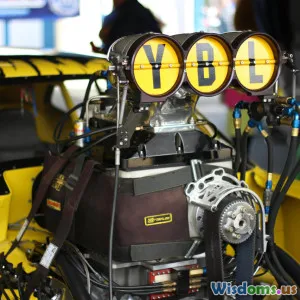
Turbocharged vs Supercharged Engines Which is Better for You
7 min read Discover the key differences between turbocharged and supercharged engines to decide which boosts your ride best. (0 Reviews)
Turbocharged vs Supercharged Engines: Which Is Better for You?
If you’re a car enthusiast or someone looking to upgrade the performance of your vehicle, you've probably heard the buzzwords “turbocharged” and “supercharged.” Both provide the thrill of extra power and acceleration, but which one is truly better suited to your needs? This article dives deep into the technology behind turbochargers and superchargers, their advantages and drawbacks, and real-world applications to help you make an informed decision.
Introduction: Power Boosting in Modern Engines
In the quest for more horsepower without increasing engine displacement, automakers and tuners have relied on forced induction systems—namely turbochargers and superchargers. These devices compress air entering the engine, allowing more air (and fuel) into the combustion chamber, yielding greater power output.
Deciding between the two is not just a matter of preference; it's about understanding how each system works, the driving experience it offers, and implications on maintenance, fuel economy, and cost.
Understanding the Basics
What is a Turbocharged Engine?
A turbocharger harnesses the energy of exhaust gases to spin a turbine connected by a shaft to a compressor wheel, which squeezes more air into the engine cylinders. Because turbochargers recycle exhaust energy, they're considered more efficient.
Real-World Example:
The Porsche 911 Turbo employs a twin-turbo setup that delivers exhilarating speed and efficiency, showcasing how effectively exhaust-driven turbines can boost performance without a significant fuel penalty.
What is a Supercharged Engine?
A supercharger is mechanically driven directly by the engine’s crankshaft, usually via a belt. It pushes additional air into the cylinders by compressing it, providing instant boost without waiting for exhaust pressure.
Real-World Example:
The Dodge Challenger SRT Hellcat’s roots-blowing supercharger offers immediate throttle response and an unmistakable growl, appealing to muscle car fans seeking raw power.
Performance Comparison
Power Delivery & Lag
- Turbochargers: One common criticism is 'turbo lag'—a delay from throttle application to boost delivery because the turbine needs enough exhaust flow to spool. Modern turbos have minimized this with technologies like twin-scroll turbos and variable-geometry designs.
- Superchargers: Since they are mechanically linked, superchargers provide instantaneous boost and low-end torque, enhancing throttle responsiveness.
Efficiency and Fuel Economy
- Turbos generally offer better fuel efficiency because they reuse energy from the exhaust and boost power only when needed.
- Superchargers, always spinning with the engine, tend to decrease fuel economy slightly due to continuous parasitic drag.
Heat Management
- Turbocharged units increase exhaust system heat significantly and often require intercooling setups.
- Superchargers also increase intake air temperature but typically less than turbos.
Installation & Maintenance
Complexity
- Turbo systems are more complex with exhaust plumbing and require precise tuning.
- Superchargers offer simpler installation owing to direct mechanical linkage but still need reliable belt systems.
Reliability
- Both systems add mechanical stress, but modern superchargers are generally viewed as simpler to maintain.
- Turbos can suffer from bearing failures or oil starvation if not properly cared for.
Use-Case Analysis: Which Is Better for You?
Daily Drivers and Fuel Efficiency Seekers
If fuel economy and smooth power delivery are priorities, turbocharged vehicles shine. Models like the Ford EcoBoost lineup have demonstrated turbochargers’ ability to deliver power without sacrificing mileage.
Performance Enthusiasts & Drag Racing
The instant power of superchargers makes them popular on drag strips and muscle cars. For example, the Chevrolet Camaro ZL1 uses a supercharger to deliver aggressive throttle response and high peak torque.
Off-Roading and Reliability
Supercharged engines can be more durable in rugged environments since they don’t rely on exhaust flow. They also deliver torque instantly, valuable for crawling or trail driving.
Expert Insights
John Heinricy, a renowned automotive engineer, said in an interview:
“Choosing between a turbo or supercharger really depends on your driving style. Do you want instant throttle response or optimal efficiency at different speeds?”
Industry trends show a growing preference for turbocharging in passenger cars due to emissions regulations, while superchargers remain favored in niche, high-performance segments.
Conclusion: Weighing Your Choice
Both turbocharged and supercharged engines have distinct characteristics:
- Turbocharged engines excel in fuel efficiency and peak horsepower but often exhibit lag.
- Supercharged engines offer immediate power and iconic sound at the expense of fuel economy.
Ultimately, the better choice hinges on your driving patterns, maintenance tolerance, and the experience you seek behind the wheel. For daily commuting with an efficiency bonus, turbochargers lead the way. If you crave instant throttle punch combined with straightforward mechanics, a supercharged model awaits you.
Armed with these insights, you can now approach your next vehicle purchase or modification plan with confidence, turbocharger or supercharger in mind.
References
- Porsche 911 Turbo Technical Overview
- Dodge Challenger SRT Hellcat Review
- Heinricy, John. "Forced Induction Engines," SAE Technical Paper, 2017.
- Car and Driver, "Turbocharged vs Supercharged: The Power Battle," 2020.
Author's note: Always consult with automotive professionals and consider personal needs before modification or purchase.
Rate the Post
User Reviews
Popular Posts





















